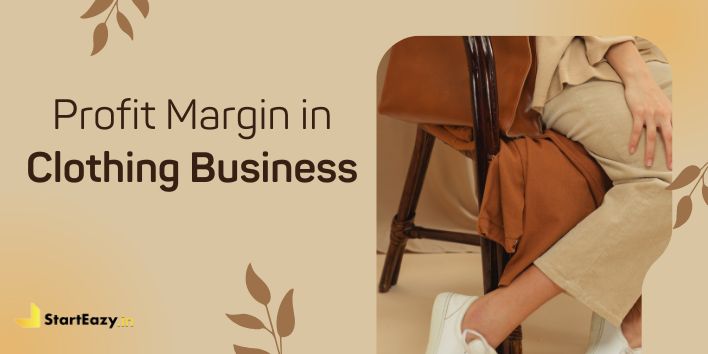Profit Margin in Clothing Business | Guide for Startups

Profit Margin in Clothing Business is 30% to 60%. But, for international and Eco-friendly brands, the margin rate is usually even higher than this.
Not to mention that if your clothing business idea is unique and has low production costs, you can easily keep your profit margin starting from 50%.
Overview of Clothing Business in India
- Investment: Rs. 10 Lacs (minimum)
- Area Required: 500 sq ft. to 800 sq ft. (minimum)
- Human Resource: 10 - 15 skilled people (initially)
- Clothing Business Profit Margin: 30% - 60%
- Estimated Earnings: Rs. 7 Lacs to Rs. 8 Lacs (initially)
The profit margin in the clothing business varies depending on the company's size, production costs, and pricing strategies.
For example, a small manufacturer might have a profit margin of 10% -15% while an established brand might have a profit margin of 50%.
Types of Clothing Businesses and their Profit Margin
There are many types of clothing businesses. Some of the business types include:
- Retail Clothing Stores
- Manufacturers
- Fashion Designers
- Wholesalers
- Apparel Distributors
- Importers and Exporters
Retail Clothing Stores
Profit Margin - 40% - 45%
A retail clothing store is a store where you can buy clothing, accessories and personal items. These stores carry all types of clothing from many different brands.
Manufacturers
Profit Margin - 10% - 20%
A manufacturer is a firm that designs, manufactures and markets its products. It usually makes the goods or goods for other companies such as retailers or manufacturers. The goods manufactured might be in their brand name or on contract for other brands.
Fashion Designers
Profit Margin - 40% - 60%
Fashion designers create and design clothes for the fashion market. They may also work with production companies and manufacturers to get garments made. The world of clothing manufacturing is a very large one, but some of the key players involved include.
Apparel Distributors
Profit Margin - 25% - 30%
Apparel Distributors are distributors that sell to retailers, wholesalers and manufacturers through their network and supply chain.
Importers and Exporters
Profit Margin - 15% - 20%
Importers are firms that buy products from exporters in other countries. The exporter is the term used for a firm or individual who exports goods. A company can also be an importer when it buys a product from other countries like Japan.
Expected Gross Profit in Clothing Business
Gross profit is an important metric for businesses because it is one of the most important predictors of future profitability.
A company that has a low gross margin may have trouble competing in its industry.
The gross profit of a clothing business is the difference between the selling price and the cost of goods sold.
It is calculated by subtracting the cost of goods sold from the selling price.
The cost of goods sold is a measure of how much it costs to make and sell a product. It includes materials, labor, and other costs necessary to produce a product.
For example, if you sell an item for $100 and spend $50 to manufacture it, your gross profit is 50%. If you sell that same item for $100 and spend $30 to manufacture it, your gross profit is 66%.
For example, if you sell an item for Rs.500 and spend Rs.300 to manufacture it, your gross profit is 40%.
But, if you sell that same item for Rs.500 and spend Rs. 250 to manufacture it, your gross profit is 50%.
Investment
The minimum investment required to start a clothing business is:
- Rs. 5 Lacs for small retail store
- Rs. 10 Lacs for medium size retail store
- Rs. 15 - 20 Lacs for showroom
- Rs. 20 - 30 Lacs for manufacturing
- Rs. 10 - 15 Lacs for Import-Export
The investment required for a clothing business depends on factors like:
- Type of clothes
- Location
- Kind of products
The estimated investment can be figured out by looking at various aspects like rent, employee costs, raw material costs and marketing costs.
Investment in raw materials includes the cost of fabric, buttons, zippers, thread etc., while labour costs include the cost of tailors, seamstresses and pattern cutters.
Moreover, one needs to invest in designing the product as well.
The design of the product is an important factor that determines if it will sell or not.
Mandatory Legal Registrations
The next thing is investing in legal registrations. Most people take it lightly and then face the consequences soon.
Thus, do not make this mistake and get the important legal registrations and licenses before starting your operations.
Here is a list of mandatory registrations for clothing businesses:
- Business Registration
(You can apply for any of the following depending on your requirements - Private Limited Company Registration Online, One Person Company, Sole Proprietorship, Limited Liability Partnership, Partnership Firm)
- GST Registration
- Shop and Establishment Act
- IEC Code (Importer-Exporter Code for trading globally)
- Trademark Registration (for establishing a brand name)
The total investment in legal registrations for the clothing business will be around Rs. 10,000 - Rs. 25,000.
Get in touch with our experts to make the legalities easier for you.
The initial investment required to start a clothing business is high because you need to buy the raw material and machinery and rent a place for your factory.
There are also other regular expenses such as electricity bills, transportation etc.
After that, there are the ongoing costs which depend on the size of your factory, number of staff etc.
Sources of Fund for Business
When we are talking about investment, here are some sources of funds that can be of help:
- Bank Loan
- Venture Capital
- Angel Investors
- Partnership Funding
- Borrowing from friends or family
- Self Funding
- Loan on Property
- Government Funding
Area
The minimum area required for the clothing business is 500 sq ft - 1000 sq ft depending on the type of business.
For example, a factory requires more space than a boutique.
The two main factors that affect the area required for a clothing business are:
- Number of people who will be working in the office
- Type of work that will be done in the office
- Size of Machines
- Inventory Storage
Keep in mind that a clothing store needs a lot of space to display all the clothes and accessories.
Additionally, choosing the right location for a clothing business is crucial in determining the success of your business.
The following are some factors to consider:
- Is the area accessible?
- Is it near a transportation hub or public transit?
- Will customers have access to parking?
- How much foot traffic will there be in this area?
- What kind of competition does this area have?
- How much rent does this location cost?
Human Resource
The people you hire need to be able to handle all the different aspects of the business.
It includes working with clients, managing inventory, and processing orders.
In fact, these tasks are not easy and they require a lot of time and effort.
Hence, it is important to have well-trained and experienced employees in these positions.
Human resources required for the clothing business can be categorized into two groups: -
- The people who design and make the clothes.
- The people who sell the clothes.
With this in mind, you will need the following people for a clothing business: -
- Designers
- Marketing managers
- Accountants
- Salespersons
- Merchandisers
- Warehouse staffs
- Security
Clothing businesses are known for their high demands for human resources.
For example, a designer will need at least a few assistants in order to produce quality designs at scale and make sure that they keep up with the latest trends in fashion.
On the other hand, a small, home-based clothing business will require only a few people.








